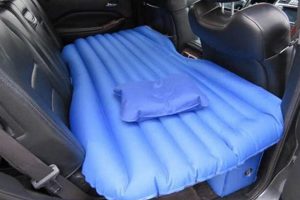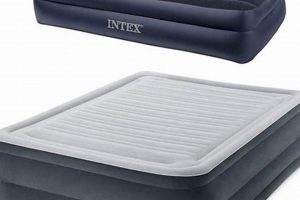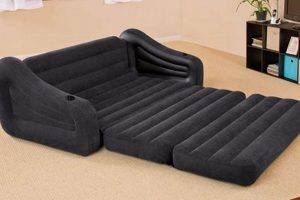Addressing perforations in inflatable sleeping surfaces is a process aimed at restoring functionality and preventing air loss. This typically involves identifying the source of escaping air, cleaning the affected area, and applying a suitable patching material or adhesive to create an airtight seal. For example, a small puncture in the mattress’s surface can be addressed by using a vinyl repair kit designed for inflatable products.
Maintaining the integrity of inflatable sleeping surfaces offers several advantages. It extends the lifespan of the product, preventing premature disposal and reducing waste. Moreover, a properly functioning mattress ensures a consistent and comfortable sleep experience, which is particularly crucial for temporary bedding solutions used during travel or for accommodating guests. Historically, techniques for mending inflatable items have evolved from simple fabric patches and adhesives to more advanced materials and application methods, reflecting advancements in material science and manufacturing processes.
The subsequent sections will provide a detailed exploration of methods for identifying perforations, suitable repair materials and techniques, and preventative measures to minimize the likelihood of future damage.
Air Mattress Leak Repair Tips
Effective maintenance prolongs the life of inflatable mattresses. The following tips detail recommended practices for detecting and resolving leaks, as well as preventing future damage.
Tip 1: Detect Leaks Methodically. Use a soapy water solution applied with a sponge or spray bottle. Slowly and systematically cover the entire surface. Bubbles indicate the precise location of the escaping air.
Tip 2: Clean the Repair Area Thoroughly. Before applying any patching material, clean the area surrounding the leak with isopropyl alcohol. This removes any dirt, oil, or debris that could compromise the adhesive bond.
Tip 3: Use Appropriate Patching Materials. Vinyl repair kits specifically designed for inflatable products are recommended. Avoid using general-purpose adhesives that may not be compatible with the mattress material.
Tip 4: Apply Even Pressure During Curing. After applying the patch, place a weight on top of the repaired area for the recommended curing time. This ensures a strong and uniform bond between the patch and the mattress.
Tip 5: Reinforce High-Stress Areas. For leaks occurring near seams or corners, consider using a larger patch that extends beyond the immediate area of damage to provide additional support and prevent recurrence.
Tip 6: Allow Adequate Drying Time. After patching, inflate the mattress partially and allow it to sit for at least 24 hours before full inflation and use. This ensures the adhesive has fully cured and the repair is secure.
Tip 7: Store the Mattress Properly. When not in use, deflate the mattress completely, fold it neatly, and store it in a cool, dry place away from direct sunlight. This minimizes the risk of punctures and material degradation.
Applying these practices ensures effective and durable repairs, thereby extending the lifespan and usability of inflatable sleeping surfaces.
The following section will elaborate on long-term maintenance strategies and advanced repair techniques.
1. Leak Detection
Leak detection constitutes the initial and most crucial phase in the restoration of inflatable mattresses. Undetected perforations render subsequent repair attempts ineffective. Without accurately identifying the location of escaping air, efforts to seal the breach are fundamentally misdirected, leading to a continued decline in air pressure and a non-functional sleeping surface. For example, a slow leak, often nearly imperceptible, can gradually deflate the mattress over several hours, resulting in a disturbed sleep cycle. Properly identifying the source of the leak, whether through visual inspection, auditory cues, or the application of soapy water, dictates the appropriate repair strategy and ensures its ultimate success.
Effective methodology in this process includes a systematic examination of the mattress surface, particularly along seams and around the valve, where stress concentration is highest. The application of a mild soapy solution aids in visualization, as the escaping air generates bubbles at the perforation point. This precise identification allows for targeted cleaning and patching, optimizing the adhesive bond and minimizing the risk of future air loss. Neglecting to thoroughly investigate the entirety of the mattress surface may result in overlooking multiple, smaller leaks, rendering even a well-executed patch job insufficient.
In summary, leak detection is not merely a preliminary step, but an integral component of successful repair. Its accuracy directly influences the durability and effectiveness of the entire process. Overlooking this stage renders subsequent repair efforts futile, emphasizing the importance of diligent examination and precise identification of all perforations before commencing the patching procedure. This meticulous approach is the foundation for restoring the functionality and extending the lifespan of inflatable mattresses.
2. Surface Preparation
Surface preparation is a critical precursor to effective air mattress leak repair. The presence of contaminants, such as dirt, oils, or residual cleaning agents, on the mattress surface hinders the formation of a secure adhesive bond between the patching material and the mattress itself. This compromised bond results in a higher likelihood of patch failure, leading to recurring air loss and ultimately, the need for repeated repair attempts. For example, if dust particles are present on the vinyl surface when applying a patch, the adhesive will bond to the dust instead of the mattress material, weakening the seal and potentially causing it to peel away under pressure.
The appropriate method of surface preparation typically involves the use of a mild cleaning agent, such as isopropyl alcohol, applied with a clean, lint-free cloth. This process removes surface contaminants without damaging the mattress material. It is important to allow the cleaned area to dry completely before proceeding with the application of the patch and adhesive. Failure to ensure complete dryness can introduce moisture that interferes with the curing process of the adhesive, further weakening the bond. In practical terms, neglecting this step translates directly to a less durable and less reliable air mattress repair.
In conclusion, proper surface preparation is not merely a supplementary step but a foundational element of successful air mattress leak repair. It directly impacts the strength and longevity of the repair, ensuring that the patch adheres securely and provides a lasting seal against air leakage. The challenges associated with inadequate preparation, such as premature patch failure, unders
core its importance within the broader context of mattress maintenance and restoration.
3. Patch Selection
The selection of an appropriate patching material is a pivotal factor in successful air mattress leak repair. The patch’s material composition, size, and adhesive properties must be carefully considered to ensure a durable and airtight seal. Inappropriate patch selection can result in premature failure, rendering the repair ineffective and necessitating repeated interventions.
- Material Compatibility
The patching material must be compatible with the air mattress’s construction, typically vinyl or a similar polymer. Using an incompatible material can result in poor adhesion and eventual separation. For instance, a fabric patch applied to a vinyl mattress using standard glue may not form a sufficient bond, leading to air leakage over time. A vinyl-specific patch, coupled with vinyl adhesive, ensures proper chemical bonding and a more durable repair.
- Patch Size and Coverage
The size of the patch must adequately cover the damaged area, extending beyond the perimeter of the leak to distribute stress and prevent tearing. A patch that is too small may fail to adequately seal the perforation, particularly if the surrounding material is weakened or stressed. As a rule, the patch should extend at least one inch beyond the visible edges of the damage.
- Adhesive Properties
The adhesive used in conjunction with the patch must exhibit strong bonding characteristics and resistance to environmental factors, such as temperature fluctuations and moisture. A weak adhesive will result in a compromised seal, allowing air to escape and undermining the repair. It is imperative to use adhesives specifically formulated for flexible plastics, as these are designed to maintain their bond integrity even under deformation.
- Patch Flexibility and Conformability
The patch should be flexible enough to conform to the contours of the air mattress surface, especially in areas near seams or edges. A rigid patch may create stress points and eventually detach, particularly during inflation and deflation cycles. Patches that are designed to stretch and flex with the mattress material provide a more secure and lasting repair.
Ultimately, the effectiveness of air mattress leak repair hinges on the proper selection of a patch that is materially compatible, appropriately sized, adheres strongly, and conforms flexibly to the mattress surface. Neglecting any of these factors can compromise the repair’s integrity and necessitate further intervention. Choosing high-quality, purpose-designed patches significantly increases the likelihood of a successful and durable solution to air mattress perforations.
4. Adhesive Application
Adhesive application is a critical determinant of success in air mattress leak repair. The bond created by the adhesive is the primary mechanism by which the patch adheres to the mattress, sealing the perforation and preventing further air loss. Inadequate adhesive application, whether due to insufficient quantity, improper distribution, or use of an inappropriate adhesive type, directly leads to a compromised seal. For example, a thin and uneven application of adhesive might create weak spots that allow air to escape under pressure, nullifying the repair effort.
The type of adhesive used is directly related to the material of the air mattress and the patch. Adhesives formulated for vinyl are typically solvent-based, creating a chemical bond with the mattress material. These adhesives soften the surfaces to be joined, allowing them to fuse upon curing. Other types of adhesives, such as cyanoacrylates (commonly known as super glue), may not be flexible enough to withstand the stretching and flexing of the mattress material, leading to brittle failures. Furthermore, the application technique matters; a roller or brush can ensure even distribution, while direct application from a tube may lead to excessive adhesive in some areas and insufficient adhesive in others. This can then lead to uneven bond strength across the surface of the patch.
In summary, effective air mattress leak repair depends heavily on proper adhesive application. The right adhesive must be selected, applied in the correct quantity and with even distribution, and allowed to cure fully according to the manufacturer’s instructions. Failure to meet these requirements compromises the integrity of the repair, shortening the lifespan of the fix and ultimately, requiring further intervention. The practical implication is that spending time and effort to apply adhesive correctly significantly increases the chances of a long-lasting and effective seal.
5. Curing Time
Curing time represents a critical, yet often underestimated, phase in the process of air mattress leak repair. It denotes the period required for the adhesive used in conjunction with the patch to fully set and establish a durable bond with the mattress material. Insufficient curing time directly correlates with diminished bond strength, leading to premature patch failure and subsequent air leakage. For example, if an adhesive requires 24 hours to achieve full strength, premature inflation of the mattress after only 12 hours may place undue stress on the uncured bond, causing it to weaken or separate entirely. The consequence is a failed repair and the necessity for a repeated patching attempt.
The optimal duration of curing time is contingent upon the specific type of adhesive employed, the ambient temperature, and the humidity levels. Manufacturers typically provide explicit guidelines on curing time, which should be strictly adhered to. Elevated temperatures and low humidity can accelerate the curing process, while lower temperatures and high humidity may prolong it. Moreover, applying pressure to the patched area during curing can improve bond strength by ensuring uniform contact between the patch and the mattress surface. Ignoring these variables can result in an inadequate bond, increasing the probability of future leakage and requiring rework. To illustrate, a vinyl adhesive may require longer curing times in cold weather, while a rapid-cure epoxy might be less affected by temperature fluctuations.
In conclusion, proper curing time is not merely a procedural step in air mattress leak repair; it is a fundamental determinant of the repair’s long-term efficacy. The investment of patience and adherence to recommended curing protocols significantly enhances the durability and reliability of the patch, mitigating the risk of recurrent air loss and extending the usable lifespan of the mattress. Therefore, prioritizing curing time is crucial for achieving a successful and lasting restoration of an inflatable sleeping surface.
6. Proper Storage
Inflatable mattress longevity is significantly influenced by storage practices. Improper storage conditions frequently contribute to material degradation, increasing the susceptibility
to punctures and subsequent air leaks. Exposure to extreme temperatures, direct sunlight, or sharp objects during storage elevates the risk of damage requiring repair. For instance, folding a mattress tightly and storing it in a damp environment can lead to material breakdown and the formation of mold, both of which can compromise the integrity of the mattress and necessitate repairs. Conversely, appropriate storage minimizes these risks, decreasing the likelihood of needing to address leak issues. Proper storage is an often overlooked component of preventing damage and maintaining the functionality of inflatable mattresses.
Implementing effective storage protocols involves several key steps. Before storage, the mattress should be fully deflated, cleaned, and dried to prevent moisture-related damage. Folding the mattress loosely, rather than tightly creasing it, reduces stress on the material. Storing the mattress in a dedicated bag or container protects it from physical abrasions and environmental factors. A cool, dry, and dark storage location further mitigates the risk of material degradation and prolongs the mattress’s lifespan. Regular inspections of the stored mattress can identify potential issues, such as pest infestations or material weaknesses, before they escalate into significant damage requiring extensive repairs.
In summation, proper storage practices are inextricably linked to the need for air mattress leak repair. Adhering to recommended storage guidelines reduces the incidence of damage-related air leaks, thereby extending the usable life of the mattress and minimizing the frequency of repairs. The cumulative effect of correct storage translates to both cost savings and improved user experience, emphasizing the practical significance of adopting responsible storage habits.
Frequently Asked Questions
This section addresses common inquiries regarding the identification, remediation, and prevention of air leaks in inflatable mattresses. The information provided aims to enhance understanding and improve the effectiveness of repair efforts.
Question 1: What are the primary indicators of a leak in an air mattress?
A gradual loss of inflation pressure over time is the most common symptom. Audible hissing sounds or the presence of bubbles when a soapy water solution is applied to the mattress surface can also indicate a leak’s location.
Question 2: What tools and materials are typically required for effective air mattress leak repair?
Essential items include a soapy water solution, a clean cloth, isopropyl alcohol, a vinyl repair kit (containing patches and adhesive formulated for flexible plastics), scissors, and a weight for applying pressure during the adhesive curing process.
Question 3: How should the surface of an air mattress be prepared prior to applying a patch?
The area surrounding the leak should be thoroughly cleaned with isopropyl alcohol to remove any dirt, oils, or debris that could compromise the adhesive bond. The cleaned area must be completely dry before proceeding.
Question 4: What type of adhesive is recommended for patching air mattresses?
Adhesives specifically designed for flexible plastics, such as vinyl, are recommended. These adhesives are formulated to maintain their bond integrity even under deformation and temperature fluctuations. General-purpose adhesives may not provide a durable seal.
Question 5: How long should a patched air mattress be allowed to cure before use?
The recommended curing time varies depending on the adhesive used. Generally, a minimum of 24 hours is advisable to ensure a strong and uniform bond. The manufacturer’s instructions should always be consulted for specific curing time recommendations.
Question 6: What storage practices can minimize the risk of future leaks in air mattresses?
Air mattresses should be fully deflated, cleaned, and dried before storage. They should be folded loosely and stored in a cool, dry, and dark location away from sharp objects and extreme temperatures. A dedicated storage bag or container can provide additional protection.
Successful and durable repairs can be achieved through diligent adherence to established procedures and the utilization of appropriate materials.
The next section will cover Advanced Troubleshooting
Air Mattress Leak Repair
This exploration has outlined effective strategies for addressing perforations in inflatable mattresses. From methodical leak detection and meticulous surface preparation to the selection of compatible patching materials and adherence to recommended curing times, the process necessitates diligence. Proper storage, as emphasized, further minimizes the risk of future damage and extends the lifespan of these sleeping surfaces.
Ultimately, responsible stewardship of inflatable mattresses demands a proactive approach to maintenance and repair. The principles and practices detailed herein serve as a foundation for ensuring the continued functionality and utility of these commonly used items. Consistent application of these methods represents a tangible investment in both product longevity and user satisfaction. Prioritizing these steps is crucial for preserving both the integrity of these items and the comfort they provide.







